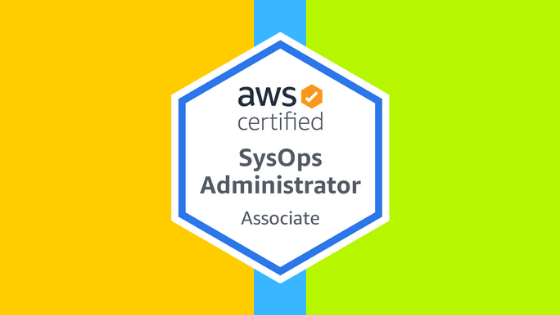AWS SysOps Administrator Certification Training

CertOcean's AWS SysOps Certification Training is designed to help you pass the AWS Certified SysOps Administrator Associate Exam. Learn how to create automatable and repeatable deployments of networks and systems on the AWS platform using AWS features and tools related to configuration and deployment. You will also gain expertise in services like Cloudwatch, Cloudtrail, ELB, Route53, EC2, S3, Glacier, IAM and VPC.
Why should you take AWS SysOps Administrator?
- Amazon Web Services certification is rated as the most valued IT Certification - Global Knowledge Study.
- The global market for cloud computing could grow from $40 billion
in 2015 to $ 241 billion in 2025
- Average salary of AWS Certified SysOps Admin is $112k - Indeed.com
Course Curriculum
Goal : In this module, you will you will learn compute services offered by AWS. We will cover different Amazon AMIs, a demo on launching an AWS EC2 instance, connect with an instance and hosting a website on AWS EC2 instance.
Objectives : At the end of this module, you should be able to: Understand Cloud Computing, Understand AWS Availability Zones and Regions.
Topics : Cloud Computing, Cloud Services, Amazon Web Services (AWS), AWS Global Infrastructure.
Hands on : Signing Up for a Free Tier Account with AWS.
Goal : In this module, you will you will learn compute services offered by AWS. We will cover different Amazon AMIs, a demo on launching an AWS EC2 instance, connect with an instance and hosting a website on AWS EC2 instance.
Objectives : At the end of this module, you should be able to: Understand Amazon Machine Image(AMI), Create, Manage and Troubleshoot an Instance, Understand Security Groups, Key Pairs, Tenancy – Shared vs Dedicated, IAM, CLI, Differentiate between Elastic IP & Public IP, Define Elastic Network Interfaces(ENI).
Topics : Introduction, Amazon Machine Image(AMI), What is an Instance?, Types of Instances, Creating Instances, Managing Instances, Troubleshooting Instances, Network Interfaces, Different Categories of IP.
Hands on : Creating EC2 Instance.
Goal : In this module, you will learn about the different storage services offered by AWS and how they can be used to transfer the data.
Objectives : Define Cloud Storage, Define Types of AWS Storage, Create, Manage and Expand Amazon Elastic Block Storage(EBS), Configure Access to Amazon S3 resources, Store and retrieve Amazon S3 objects, Use Amazon Glacier.
Topics : Cloud Storage, Types of AWS Cloud Storage, Understanding AWS Storage, Amazon Elastic Block Storage(EBS), Amazon S3, Amazon Glacier, Storage Security, Storage Gateway, Snowball, Troubleshooting Storage in AWS, Pricing in AWS.
Hands on : Restoring an EBS Volume from a Snapshot, Upload and download files from Amazon S3.
Goal : In this module, you will be introduced to Virtual Private Cloud(VPC), learn about the VPC Scenarios, VPC components, VPC Peering, Configuring Subnets, Network Address Translation(NAT) and Configuring AWS EC2 instance as NAT server.
Objectives : At the end of this module, you should be able to: Understand Cloud Networking, Understand and Configure VPC, Create and Manage Networks in AWS, Configure Route Tables for NAT, Configure EC2 instance as NAT server, Manage Network Security, Troubleshoot Networks.
Topics : Amazon VPC, VPC Subnets, Route Tables, Elastic IPs, Internet Gateway, NAT Gateway, Access Control Lists(ACLs), Security Groups, Creating and Managing a VPC, Route53, Network Security, Troubleshooting Networks in AWS.
Hands on : Building a VPC Environment.
Goal : In this module, you will learn about the different database services offered by AWS to deal with structured and unstructured data.
Objectives : At the end of this module, you should be able to: Understand Different Databases services - Amazon RDS, Amazon DynamoDB, Amazon ElastiCache.
Topics : Types of Database Instances, Amazon RDS, Amazon DynamoDB, Amazon ElastiCache.
Hands on : Creating a MySQL DB Instance via Relational Database Service, Creating a table and loading data in Amazon DynamoDBGoal : In this module, you will learn 'scaling' and 'load distribution techniques'.
Objectives : At the end of this Module, you should be able to: Understand Common Deployment Scenarios, Redirect Traffic with Elastic Load Balancing(ELB), Scale to Demand with Auto Scaling.
Topics : Scaling in the Cloud, Load Balancer, Elastic Load Balancing(ELB), Auto Scaling.
Hands on : Auto Scaling to scale up the number of servers available for a specific task.
Goal : In this module, you will learn about the monitoring services offered by AWS. Setting up alerts and notifications for AWS resources and AWS usage billing with AWS CloudWatch. Also track user activity and API usage using CloudTrail.
Objectives : At the end of this module, you will be able to: Use CloudWatch, Use CloudTrail, Retrieve Instance log files with CloudWatch.
Topics : Logging Basics, CloudWatch, CloudWatch logs, AWS CloudTrail, Monitoring and Security, IAM, Troubleshooting.
Hands on : Enabling CloudTrail Log Delivery to a S3 Bucket, Configuring CloudWatch Logs agent on an Instance.
Goal : In this module, you will learn techniques in AWS to manage resource consumption and using configuration management tools.
Objectives : Upon completing this module, you will be able to: Identify cost reduction opportunities, Use Tagging, Use AWS Trusted Advisor, Create and use AMIs, Manage Routing & Traffic flow using Route53.
Topics : Identifying Cost Reduction Opportunities in the cloud, Tagging, Monitoring and Expenditure Alerting with Amazon CloudWatch, AWS Trusted Advisor, Creating Amazon Machine Images(AMI), AWS OpsWorks, AWS UserData, AWS CloudFormation, Amazon Elastic BeanStalk.
Hands on : Create a Stack using an AWS CloudFormation Template.
Course Description
CertOcean's AWS SysOps Training is created to help IT administrators and system engineers for implementing and managing resources on AWS. This training is completely aligned to AWS Certified SysOps Administrator - Associate exam.
- Create automatable and repeatable deployments of networks and systems on the AWS platform
- AWS features and tools related to configuration and deployment
- Common techniques used throughout the industry for configuring and deploying systems
- System Administrators
- Software Developers with Developer Operations (DevOps) Experience
- Cloud Professionals
"DevOps in the Cloud" is the market buzz and is the preferred learning path after AWS SysOps Training. Check out the upgraded DevOps training details
The pre-requisites for this course includes :
- Expertise in software administration or software development
- Basic understanding of networking protocols (TCP/IP, HTTP)
- Basic Knowledge of shell scripting in Linux environment, cmd or PowerShell in Windows
If you wish to brush-up Linux skills, Edureka offers you a complimentary self-paced course, i.e. "Linux Fundamentals for AWS SysOps" when you enroll in AWS SysOps Admin Training.
Features
Instructor-led live sessions
24 Hours of Online Live Instructor-led Classes. Training Schedule: 8 sessions of 3 hours each.
Assignments
Each class will be followed by practical training sessions for a better hands-on experience.
Lifetime Access
Students will get lifetime access to all the course materials where presentations, quizzes, installation guides, and class recordings are available.
24/7 expert support
We provide 24/7 support to all the students, thereby resolving technical queries.
Certification
Once you have completed your final course training and project, you will receive a certificate stating you are a AWS SysOps Administrator training certified
Frequently Asked Questions (FAQs):
You will never miss a lecture at CertOcean! You can choose either of the two options:
- View the recorded session of the class available in your LMS.
- You can attend the missed session, in any other live batch.



